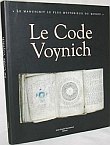No other copy of the Voynich manuscript, “the world’s most mysterious manuscript,” exists in any other collection in the world, besides the one at Yale University’s Beinecke Rare Book and Manuscript Library. The book was donated to the university library in 1969 through a gift of the legendary rare book dealer, Hans P. Kraus, who bought it following the death of Mrs. Edith Voynich. The unique work of magical or scientific text that possibly contains a formula for an Elixir of Life was recently found to date back to the early 15th century. The manuscript was discovered in the Villa Mondragone near Rome in 1912 by antique book dealer Wilfrid Voynich, in a chest filled with books offered for sale by the Society of Jesus.
Voynich dedicated the remainder of his life to unveiling the mystery of the book’s origin and deciphering its meanings that appear to be dealing with a range of topics that might relate to alchemy. Nearly every page of the manuscript’s 200 pages contains unusual botanical, figurative, and astronomical drawings in ink with vibrant shades of green, brown, yellow, blue, and red. Despite Voynich’s generosity in supplying photocopies to professional paleographers, and other intelligence experts, the text defied decipherment through his death in 1930.
The modern history of the manuscript is not much clearer, as a great deal of unsuccessful attempts to solve the mystery failed to materialize. Scholars and cryptanalysts who have worked on the cipher over the years include Robert Brumbaugh, Professor of Philosophy Yale University; Raoul Carton, professor of philosophy at the Collège Stanislas; Etienne Gilson, Thomistic philosopher and historian of philosophy at the French Academy; David Kahn, historian and cryptographer; John M. Manly, Chaucer scholar at the University of Chicago, and many others. More recently, a team from the University of Arizona’s physics department led by Greg Hodgins, using radiocarbon dating have found the manuscript’s parchment pages to date back to the early 15th century. While a good deal has been learned about the manuscript’s provenance, efforts to transcribe and decipher the manuscript continue to this day.
For the collector who is interested in owning a copy of the priceless manuscript the disappointment is obvious – none are available for sale. The closest alternative one may be able to get is to purchase a copy of a French edition of a book titled Le Code Voynich. This recent, 2005 publication by publisher Jean-Claude Gawsewitch, is currently available for sale for more than 10 times its initial release price. Did scarcity produce a rare Voynich book of modern time? Quite an achievement given that the book was not limited when it was first released but is already out of print and very difficult to locate. The quarto (4to) hardcover has 240 pages and contains the whole manuscript published with high-quality, color imagery, and a short presentation in French by Pierre Barthélémy. The book has its drawbacks. For example, the edges of the pictures are cut off and are not fitted to the full quarto book size. As a result some of the potentially useful deciphering code at the bottom of the pages is actually missing including the original page numbering.
One would expect that given the success of the initial publication, a second edition should be in the works. The independent publisher Jean-Claude Gawsewitch, however, has no plans to do so, at least not yet. In the meantime, anyone interested at examining the original, Yale University’s Beinecke Rare Book and Manuscript Library, has posted the entire manuscript for free on-line on their website.
The manuscript’s importance, needless to say, lies in what it has hiding for us about medical, botanical and cosmological sciences as well as linguistics and cryptography. Besides remaining a challenge to scholars worldwide to decipher, it has also been a challenge for book collectors that are looking for a way to add the world’s most mysterious manuscript to their collection.


{ 0 comments… add one now }
{ 2 trackbacks }